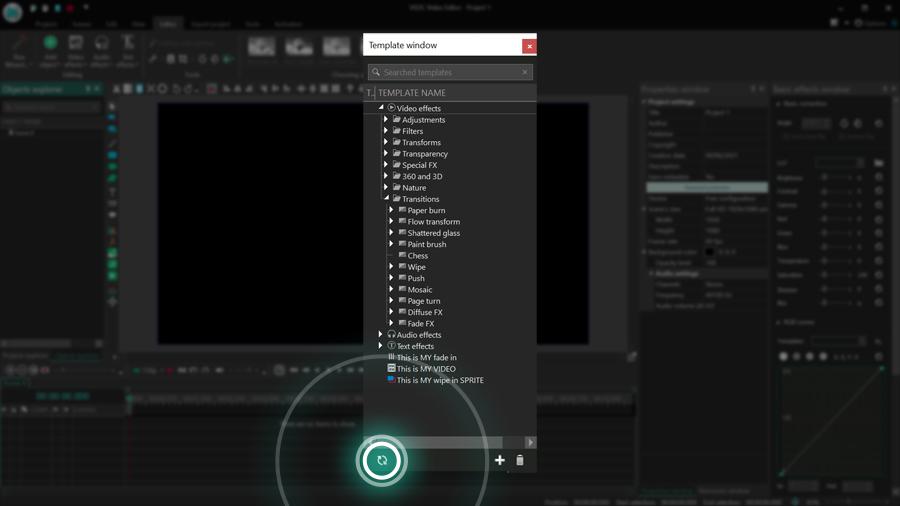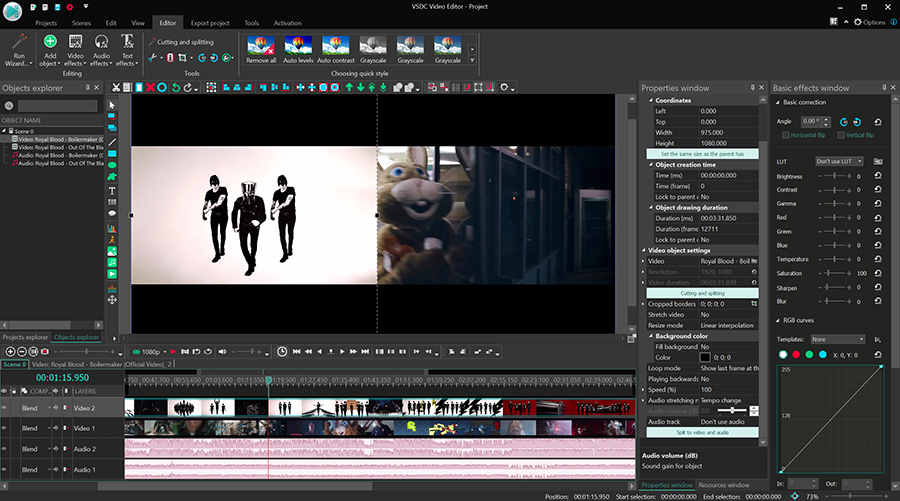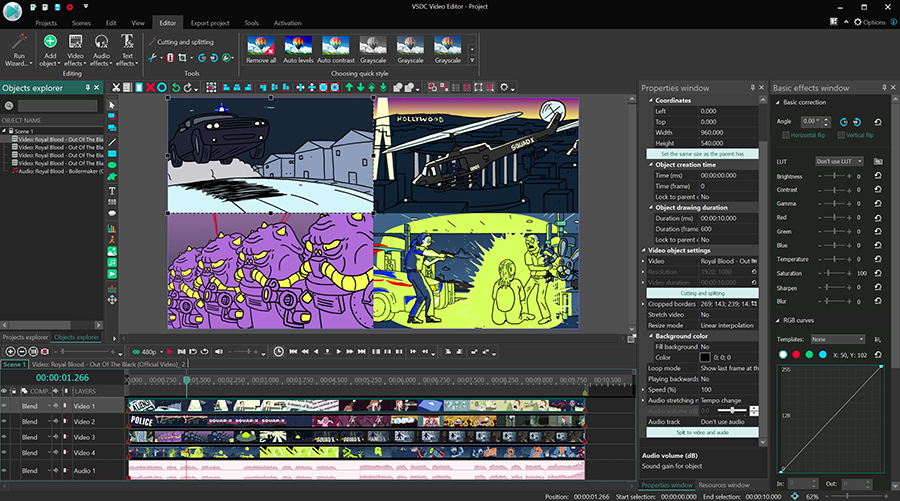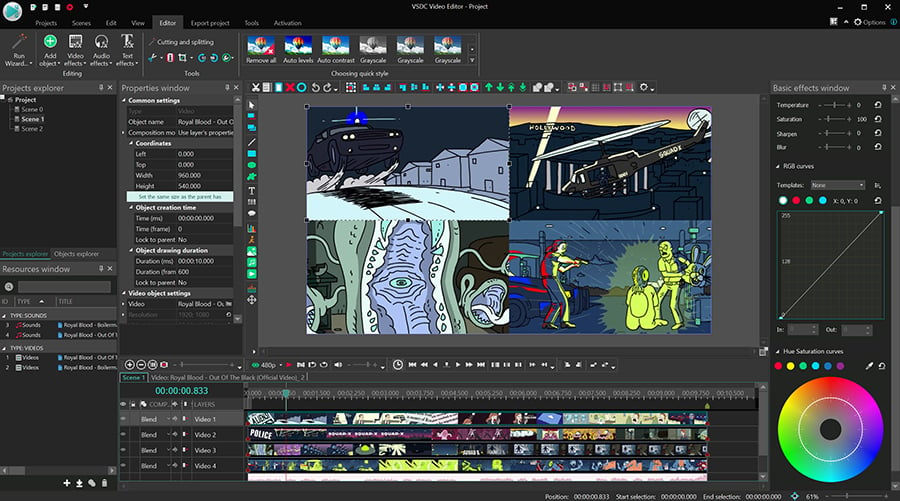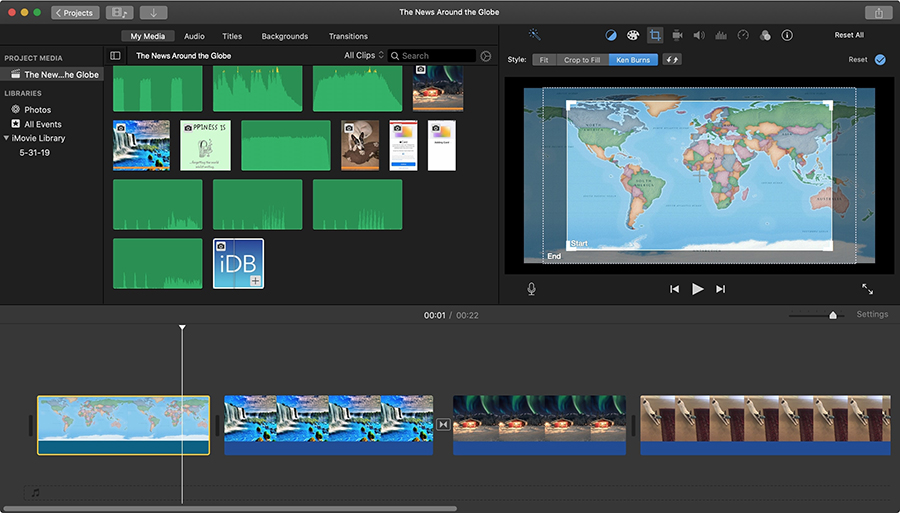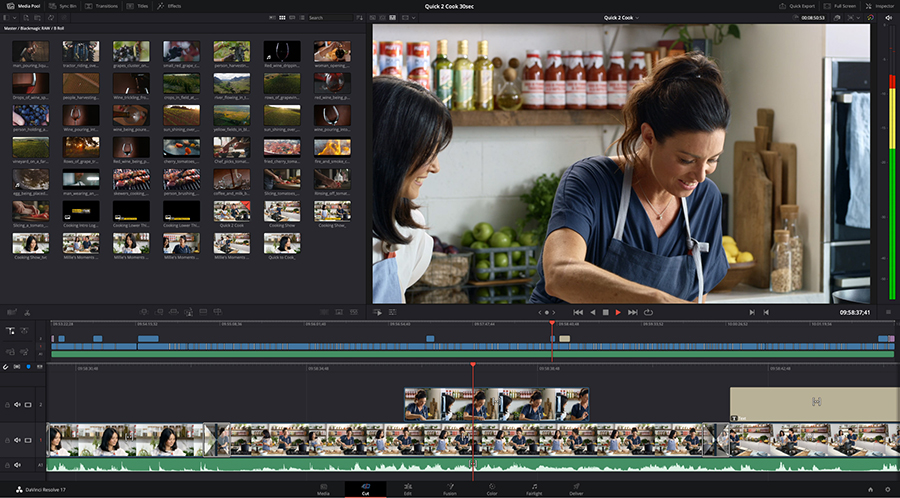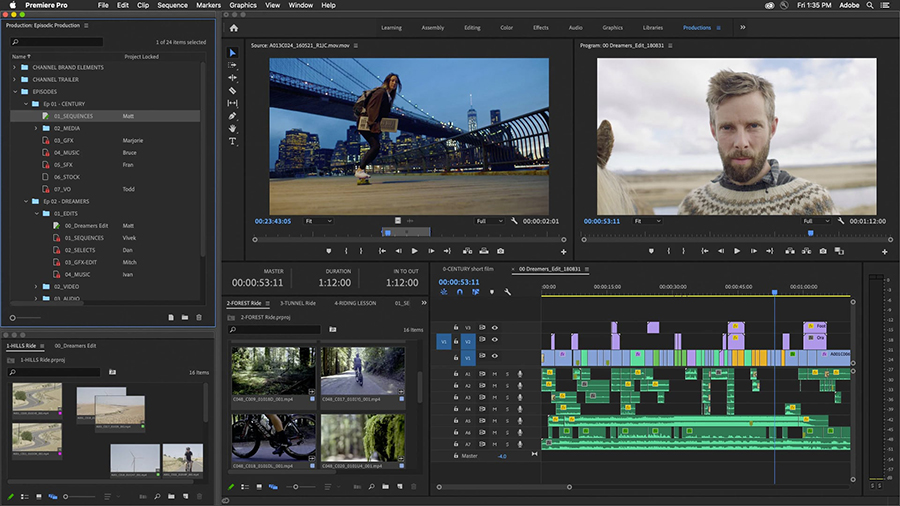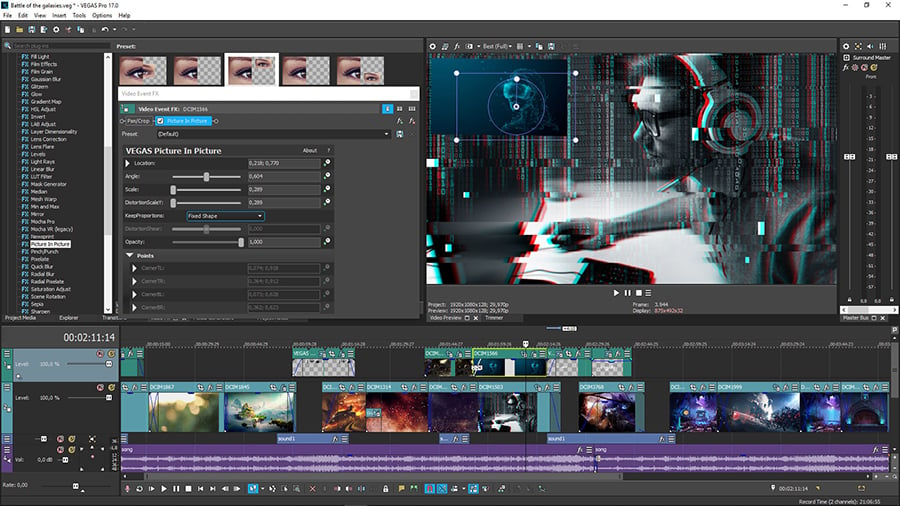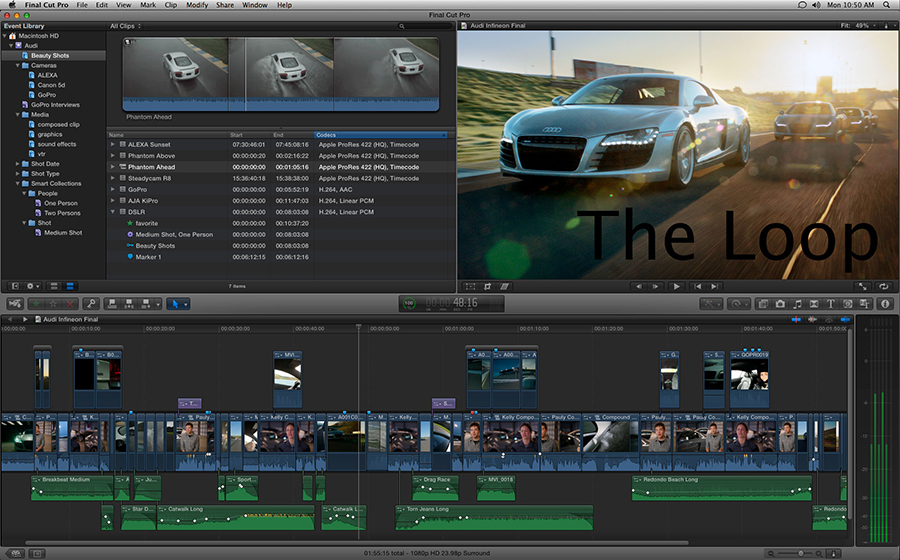Video Editor
Download and use the free video software to create and edit videos of any complexity from a family greeting card to a company presentation. Apply vsdc free video editor for light edit hdr-video, any raw-video formats from cams - BRAW, ProRes RAW, any high resolution 4k or more due to video proxies technologies in the editor.
Cut, merge video files, apply visual and audio effects, use filtration and image correction, make slideshows and add an appropriate soundtrack. Use multi-color Chroma Key and advanced parameters settings to give your video a professional look.
All popular video and audio formats are supported.
Video Converter
This program is intended for converting video files from one format to another. Nearly all popular video formats are supported (both reading and saving). In addition, the program drastically simplifies the task of converting videos for playback on specific multimedia devices, such as iPhone, Samsung Galaxy or Huawei P30 Pro. The program is extremely easy to use, has a modern interface and all necessary video processing functions.
Audio Converter
The audio converter will help you convert audio files from one format to another. All key audio formats and codecs are supported. The program also allows you to manage playlists and meta tags, extract audio from video files and save these tracks on your computer in any format.
Audio CD Grabber
This audio tool is intended for grabbing audio tracks from compact discs and saving them to the user’s computer in any format. Nearly all popular audio formats and codecs are supported. The program can also extract track details from the FreeDB server for automatic file renaming and updating meta tags.
Video Editor
Video Converter
Audio Converter
Audio CD Grabber

Multifunctionality
A wide array of multimedia processing tools in one free video software suite.

High speed
Our programs use fast
and high-quality algorithms optimized for single and multi-core CPU’s.

Affordability
VSDC video software is freely available for download to Windows OS-based PCs and laptops.
- Hi, I'm Mattea Wharton, a travel videographer from Seattle. For three years I ba...
- published Amy Shao 6/10/25 The wait for something new and unusual is finally...
- This holiday season embraces new beginnings with the latest update of VSDC Video...
- Change is all about improvement, and this process wouldn't be possible without y...
VSDC Christmas Release 2021: LUT Editor, Time Remapping, and God Rays Effect
The winter holiday season is an exciting time for many reasons. If you are a VSDC user, one of these reasons is a traditional Christmas update of the program. This year, we’re thrilled to release VSDC 6.9 boasting three brand new features: LUT editor, time remapping, and God rays effect.
However, what’s even more exciting is that VSDC Video Editor is now available in four new languages: Hindi, Turkish, Urdu, and Farsi.
Let’s go over the details below.
LUT editor
Of all the new features, the LUT editor is arguably one of the most exciting ones. In the past couple of years, we’ve gradually introduced LUT support and added 10 built-in LUTs available directly in the Basic effects window. Starting version 6.9, VSDC expands its functionality and enables you to do the following:
- create your own LUTs and save them as templates
- edit existing LUTs, including LUTs imported from 3rd-party resources
- export custom LUTs and use them in other photo or video editors
To make LUT editing possible, we’ve added a pop-up LUT editor working on the basis of an HSL histogram. By adjusting the Hue, Saturation, and Lightness values on the histogram, you’ll be able to change the LUT parameters and see the result in the preview window right away.
As long as you’re using LUTs within VSDC, the feature is completely free. However, to export LUTs from VSDC, you’ll need to have the VSDC Pro subscription.
Time remapping
Another long-awaited feature that has become available in VSDC 6.9 Pro is time remapping for moving objects. Time remapping allows you to have control of the movement speed and direction for animated objects: images, icons, text titles, and so on. The effect looks quite impressive and comes in especially handy for video intros, like the one below:
From a technical standpoint, time remapping is implemented through keyframes added to the object movement graph. You can use those keyframes to isolate any section of the graph and slow down, speed up, or even reverse the object movement for that section. Combined with rotation, motion tracking, or transition effects, time remapping can help you create a more robust object animation.
God rays effect
The group of nature-inspired video effects has received a new dramatic effect, named God rays. In nature, God rays are shaped by direct light piercing through the gaps in clouds. Because of their volume, these rays often resemble light torches or columns coming straight from the sky – hence the name of the illusion.
VSDC allows you to apply the God rays effect to any object, including videos, images, or text. Depending on the object you’ve applied it to, the light will pierce through the gaps in the hypothetical atmosphere or the object’s shape. Like all VSDC effects, this one is highly customizable, so you’ll be able to adjust the strength, brightness, and length of the light rays.
Movement map editing for motion tracking
Another important update has been added to the motion tracking module to enable movement path adjustment. Essentially, you can now convert the movement map to a curve and access the tracking points forming object movement trajectory.
From this level, it’s easy to adjust and smoothen the movement map. For example, you’ll be able to control the level of tracking precision by changing the number of tracking points and using the versatility of Bezier curves.
VSDC interface localized to new languages
Last but not least, VSDC Video Editor is now available in four new languages:
- Hindi
- Turkish
- Urdu
- Farsi
Although we are still working on the website localization, the program interface has been already translated, so when you install the new version of the editor, you’ll be able to select the preferred language right away.
Localizing VSDC to these languages was one of the most long-awaited updates of the year, and we’re excited to finally announce it. We’ve always strived for providing a non-linear editing tool that easily overcomes boundaries, be it a creator’s budget or PC processing power. With the release of version 6.9, we hope to overcome one more boundary and let more creators from all over the world benefit from VSDC.
It’s time to download VSDC 6.9
While working on this release, we’ve dedicated a lot of attention to the software performance improvement as well. Namely, the program now has better control of the memory consumption, video resizing has been optimized with hardware acceleration, and the Templates window has received built-in filters.
If you want to read the full list of VSDC 6.9 updates, enhancements, and bug fixes, you can proceed to the dedicated list of changes. If you prefer skipping straight to practice, download the new version and enjoy the new features. Should you have any questions, email us at This email address is being protected from spambots. You need JavaScript enabled to view it. or send a message through our Discord channel.
Happy holidays from the VSDC team!
You can get more information about the program on Free Video Editor' description page.
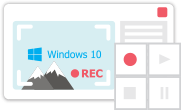
This program allows you to capture the video of your desktop and save it on your PC in various formats. Coupled with a video editor, the program is a great tool for creating presentations, tutorials and demo videos.

The program captures video from external devices and records it to computer in a free format. You can save video from video tuners, webcams, capture cards and other gadgets.

"VSDC Free Video Editor is a surprisingly powerful, if unconventional video editor"
- PC Advisor

"This video editor gives you tons of control and editing power"
- CNet

"The editor handles many common formats and boasts a good deal of capabilities when it comes time to alter lighting, splice video, and apply filters and transitions in post production"
- Digital Trends
